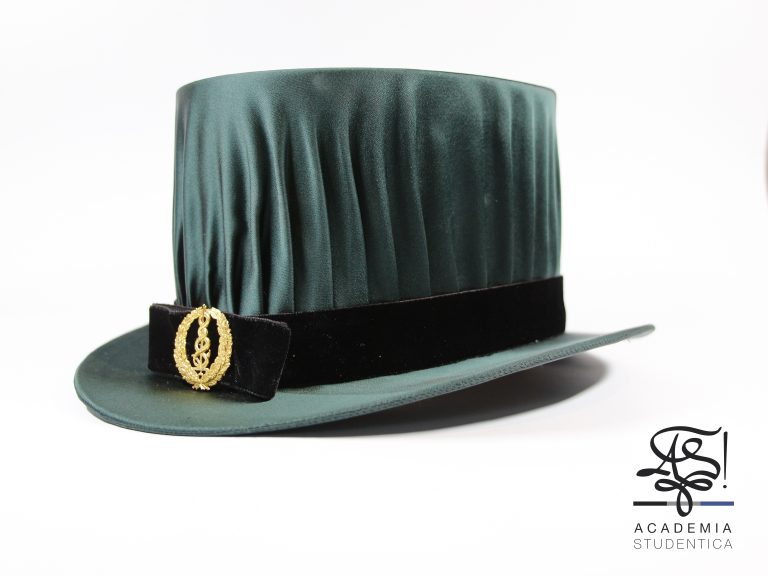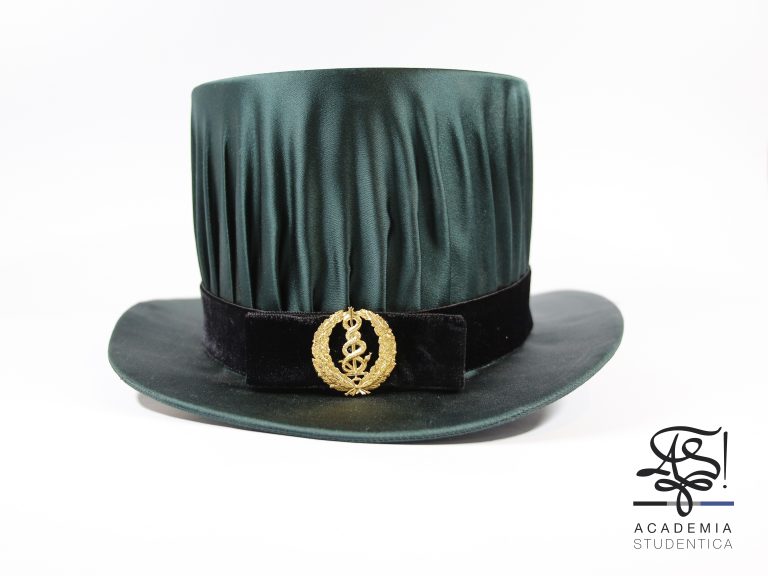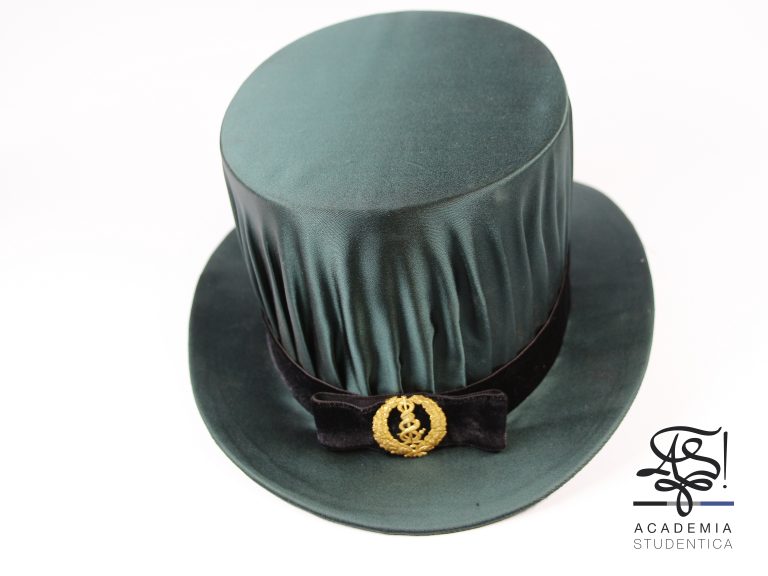Tohtorinhattu (= Doctoral Hat), Faculty of Medicine, Finland.
Coll.: Cap’n
In Finland, all new PhD holders are given a traditional PhD Sword and PhD Hat during a Conferment Ceremony. The hat symbolises liberty and the freedom of research, while the sword is a symbol of the scientist’s fight for what he/she, in rigorous research, has found to be good, right and true.
Once the university is satisfied concerning the academic requirement for earning a PhD, candidates are formally awarded their doctoral degree certificates which can be collected during graduation ceremonies similar to those in other countries, or be picked up from the university later.
In Finland you will only be considered to be a proper Dr. once you have gone through the official ceremony of Conferment where you receive a doctoral hat and sword. These ceremonies take place every few years. Doctoral degree holders that haven’t gone through this ceremony are not allowed to wear their doctoral hats at any future ceremonies requiring them and must instead carry them in their hands.
The PhD or Doctoral hat looks like a top hat, and is usually black in colour. Depending on the specific degree awarded, this colour can vary; a Doctor of Medicine, for example, receives a green hat, whilst a Doctor of Fine Arts wears a dark blue one. It also usually displays the university emblem attached to a velvet ribbon.
On the evening before conferment day, a traditional sword-whetting ceremony takes place. At this, new PhD holders bring the sword that they will officially be presented with the next day and sharpen it on a hand-turned grindstone that is turned by those who will attend the ceremony. This is usually followed by a short speech by the new doctor in which they describe the importance of the sword to them and how it symbolises the defence of knowledge and their responsibilities as a new doctoral degree holder. When the sword is worn in official ceremonies in the future, it is traditionally placed on the left side.
Tohtorinhattu (= Chapeau doctoral), Faculté de médecine, Finlande.
Coll. : Cap’n
En Finlande, tous les nouveaux titulaires d’un doctorat reçoivent une épée et un chapeau traditionnels lors de la cérémonie de remise des diplômes. Le chapeau symbolise la liberté et le libre examen, tandis que l’épée est le symbole de la lutte du scientiste pour ce qu’il/elle a découvert, au cours de ses recherches rigoureuses, comme étant bon, juste et vrai.
Une fois que l’université est satisfaite des exigences académiques requises pour l’obtention d’un doctorat, les candidats reçoivent officiellement leur certificat de doctorat, qu’ils peuvent récupérer lors de cérémonies de remise des diplômes similaires à celles qui ont lieu dans d’autres pays, ou qu’ils peuvent récupérer plus tard à l’université.
En Finlande, vous ne serez considéré comme un véritable docteur qu’après avoir participé à la cérémonie officielle de confirmation au cours de laquelle vous recevrez un chapeau et une épée de docteur. Ces cérémonies ont lieu à intervalles de quelques années. Les titulaires d’un doctorat qui ne sont pas passés par cette cérémonie ne sont pas autorisés à porter leur chapeau de docteur lors des futures cérémonies qui l’exigent et doivent le porter à la main.
Le chapeau de doctorat ressemble à un chapeau haut de forme et est généralement de couleur noire. Cette couleur peut varier en fonction du diplôme spécifique obtenu ; un docteur en médecine, par exemple, reçoit un chapeau vert, tandis qu’un docteur en beaux-arts en porte un bleu foncé. Il porte aussi généralement l’emblème de l’université attaché à un ruban de velours.
Le soir précédant le jour de la remise des diplômes, une cérémonie traditionnelle d’aiguisage de l’épée est organisée. Lors de cette cérémonie, les nouveaux titulaires de doctorat apportent l’épée qui leur sera officiellement remise le lendemain et ils l’aiguisent sur une pierre à aiguiser tournée à la main par les personnes qui assisteront à la cérémonie. Cette cérémonie est généralement suivie d’un bref discours du nouveau docteur dans lequel il décrit l’importance de l’épée pour lui et comment elle symbolise la défense de la connaissance et ses responsabilités en tant que nouveau titulaire d’un doctorat. Lorsque l’épée sera portée lors de cérémonies officielles à l’avenir, elle sera traditionnellement placée sur le côté gauche.
Tohtorinhattu (= Doctoraatshoed), Faculteit Geneeskunde, Finland.
Coll.: Cap’n
In Finland krijgen alle nieuwe gepromoveerden tijdens een uitreikingsceremonie een traditioneel doctoraatszwaard en een doctoraatshoed. De hoed symboliseert vrijheid en de vrijheid van onderzoek, terwijl het zwaard een symbool is van de strijd van de wetenschapper voor wat hij/zij, in rigoureus onderzoek, heeft ontdekt als zijnde goed, juist en waar.
Wanneer de universiteit tevreden is over de academische vereisten voor het behalen van een doctoraat, krijgen de kandidaten officieel hun doctoraatsdiploma uitgereikt, dat kan worden afgehaald tijdens afstudeerceremonies zoals die in andere landen plaatsvinden, of later bij de universiteit kan worden opgehaald.
In Finland wordt men pas als een echte doctor beschouwd wanneer men de officiële ceremonie van de promotie heeft doorlopen, waarbij men een doctoraatshoed en -zwaard ontvangt. Deze ceremonies vinden om de paar jaar plaats. Houders van een doctoraatsdiploma die deze ceremonie niet hebben meegemaakt, mogen hun doctoraatshoed niet dragen bij toekomstige ceremonies waarbij dat vereist is en moeten de hoed in hun hand houden.
De doctoraats- of doctorshoed ziet eruit als een hoge hoed en is meestal zwart van kleur. Afhankelijk van de specifieke academische opleiding kan deze kleur variëren; een doctor in de geneeskunde krijgt bijvoorbeeld een groene hoed, terwijl een doctor in de schone kunsten een donkerblauwe draagt. Op de hoed staat meestal ook het universiteitsembleem dat aan een fluwelen lint is bevestigd.
Op de avond vóór de dag van de promotie vindt de traditionele ceremonie van het slijpen plaats. Hierbij brengen de nieuwe doctorandi het zwaard dat zij de volgende dag officieel zullen krijgen en slijpen zij het op een met de hand gedraaide slijpsteen die wordt rondgedraaid door degenen die de ceremonie zullen bijwonen. Dit wordt gewoonlijk gevolgd door een korte toespraak van de nieuwe doctor waarin hij/zij het belang van het zwaard voor hem/haar beschrijft en hoe het symbool staat voor de verdediging van kennis en zijn/haar verantwoordelijkheden als nieuwe doctorandus. Wanneer het zwaard in de toekomst bij officiële plechtigheden wordt gedragen, wordt het traditioneel aan de linkerkant geplaatst.





